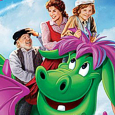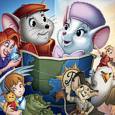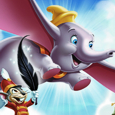Walt Disney Productions (November 3 1977), Walt Disney Home Entertainment (October 16 2012), Blu-ray and DVD discs, 129 mins (incorrectly stated as 88 mins on the packaging) plus supplements, 1080p 1.66:1 high-definition widescreen, 5.1 DTS-HD Master Audio, Rated G, Retail: $29.99
Storyboard:
Orphan Pete goes on the run from the twisted Gogan family with one very special friend: a twelve-foot, fire-breathing but loveable – and invisible! – green dragon named Elliott! Their travels take them to the fishing town of Passamaquoddy, where Pete finds a new home with lighthouse keeper Nora and her Dad Lampie, but the Gogans, despite their ineptitude, are hot on Pete’s tracks. Elliott has trouble of his own, when a power-hungry quack doctor comes to town and hears about the dragon: a creature whose natural abilities could spell the end of his grubby existence and signal a new start as a true miracle worker. Things don’t look so good for Pete and Elliott when the Gogans team up with the Doc, threatening to shatter their brazzle dazzle days forever…

The Sweatbox Review:
With the huge rush of “middle-period” Disney features (those films that came right in the midst of the period between Walt’s passing and the management takeover of 1984) coming to Blu-ray this year, I have found myself revisiting a private theory about the Studio’s ups and downs over the years. It seems, to me at least, that Disney Animation has, since its inception, gone through various changes almost every twenty years, while experiencing one tremendous success around a ten year interval within that twenty year period. Allow me to deviate a moment from the focus of this particular review and attempt to explain…
It seems, to me at least, that the Studio’s animation division “renews” its creative energies in relatively regular cycles. Walt originated his initial Studio in the early 1920s, but it was in 1926 that the first of his regular series, the Alice Comedies, first marked him out as something special. The company grew, and success came in the form of the incredibly popular Mickey Mouse cartoons and the Oscar winning Silly Symphonies, but almost twenty years on a second World War had engulfed the globe and a cartoonists’ strike heralded the end of the first chapter in the golden age of American animation.
By the mid-forties, the Studio was in something of a funk: the War had taken its toll, the films that Walt had released in the immediately preceding years had not been huge money makers, and the future of Walt Disney Productions looked bleak. From this point, the company cut its cloth accordingly and began to create an alternative line of programming; the Package Features saw Walt being able to coast along for the time being, keeping his artists in work and working back up to the kinds of animated features the Studio had become known for. This eventually happened, and the following decade was a hotbed of activity and expansion at the company.
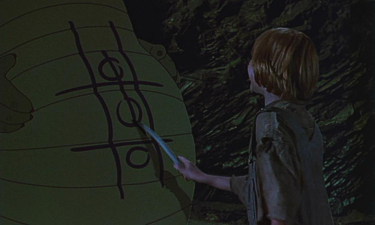
Twenty years on once more, into the mid-1960s, the Walt Disney Studios wasn’t floundering by any means, but the animation department’s costs were spiraling out of profitable reason and again the future of this division of the Disney Empire was under doubt. The Xerox process brought cost savings but worse was to come when Walt himself passed away in 1966, throwing the company into turmoil. Once again, this devastating blow was slowly overcome, and the Studio was able to organize itself through the leadership of Walt’s brother and his son-in-law, Roy O. Disney and Ron Miller respectively, and continue producing Disney entertainment for the next twenty years.
The company’s more recent fortunes are well documented, of course, the bottom line being that, almost another twenty years later, the future of not only Disney animation but the whole company was under threat. In attempts to keep up with the modern audiences of the day, the Studio had turned from college comedies and fluffy animal animated pictures to darker fare, but with films that were still aimed at family audiences. This mostly translated into movies that were not adult enough for grown-ups and too adult for kids, resulting in middling to low box-office returns, and a low company value.

In 1984, Walt Disney Productions was ripe for a takeover. The idea was to basically close the Studio, sell off the film library and keep operating the theme parks, but a management coup by Roy O’s son Roy E. Disney and the entering of Michael Eisner, Frank Wells and Jeffrey Katzenberg staved off the asset-hunting money men and ensured Walt’s legacy could continue boldly. So followed another build up of creativity and a further twenty years or so of rich Disney entertainment and further expansion for the organisation, now named The Walt Disney Company. This twenty-year period ended when micro-managing had resulted in another downturn in creativity and the Save Disney campaign, again spearheaded by Roy Disney, saw Eisner leaving his post earlier than his planned 2006 retirement.
We’re in the “middle”, if you like, of another twenty-year cycle, and one that should yield terrific creative results within the next couple of years or so. Home come? Well, I haven’t elaborated upon the successes the company has enjoyed over the years yet, which I outlined came every ten years or so…or around the “middle” of each twenty-year period. So, in the midst of Walt’s original 1920s to 1940s run, he enjoyed the huge popularity of the world’s first full color and sound animated feature Snow White And The Seven Dwarfs, the epitome of that mid-20s to mid-30s development and artistic honing at the Studio, and one that would keep those Mickey Mouse watches ticking over for the next few years.
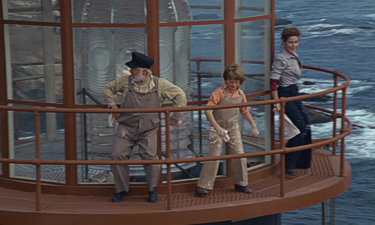
During the mid-1940s to mid-1960s period, the 1950s was a hugely prolific decade for the company: Cinderella had renewed the viability of Disney animation, yes, but it was 1955 – again right in the middle of this twenty year cycle – that marked a banner year for Walt Disney Productions, with Walt’s huge small screen impact felt on television with the debuts of his weekly one-hour anthology show and The Mickey Mouse Club and the phenomenal immediate success of the Disneyland theme park. One could argue that Mary Poppins comes at a wrong time (in 1964) to support the twenty-year theory, but the devastating death of Walt just two years later has many referring to this as his final swan song, where all the elements came together perfectly.
The animation renaissance of the mid-1990s is naturally still a part of most of our memories, inarguably the high-point of the Eisner/Wells/Katzenberg regime where The Lion King became the biggest animated film of all time – at the time – regular as clockwork, if you’re still with me, in the summer of 1994. By this reckoning, we should be about to witness some great Disney successes over the next few years: certainly the acquisitions of Pixar and Marvel has provided a boon to the company’s bottom line and, more importantly, creative aspects, but I’m not sure the peak has been reached yet; it’s going to be interesting to see what comes about in the immediate future.
Now, those keeping up and paying attention will notice I slipped over a supposed period during the mid-1960s to 1980s cycle where we should have had a success of some kind coming right around the middle of the 1970s. It’s no secret that by this time Disney films were floundering at the box-office. More edgier entertainment had eaten away at Hollywood in general, it has to be said, and a variety of musical, family entertainment from countless Studios had proven to be commercial failures. Disney actually did pretty well at maintaining a respectable level of audience assurance by way of the films they were making.

Sure, these films weren’t exactly groundbreaking, and there are only so many teenage Kurt Russell comedies one can take, but at least the audiences knew their kids were safe with the Disney brand, and reissues of past animated classics brought old films back to a new generation not yet able to re-watch and re-watch movies on home video. In terms of animation, the mid-Seventies would be a time of change at Disney Animation: Walt’s original artists were retiring and the next generation of artists were still learning their game. The AristoCats and Bedknobs And Broomsticks – both holdovers from Walt’s time – had appeared in the early part of the decade, with the entertaining but slightly lazy Robin Hood coming in 1973, but the output was low.
It would be a further four full years before audiences could get excited about any new Disney feature animation, but when it came it was all gold, and I would put 1977 forward as the successful point in my ten/twenty year Disney Animation cycle theory. This was in no doubt a banner year for the Studio, with the wait between animated films resulting in no less than three features coming to screens within this twelve month period. It’s true that The Many Adventures Of Winnie The Pooh was largely a compilation film of Pooh featurettes from 1964, ’66 and ’74, but it was also the realisation of Walt’s originally planned Pooh picture, with new linking material that provided a full and involving feature experience.
Hugely commercially successful, a film that kept the animation department alive and led to one of the Studio’s only pure theatrical sequels was The Rescuers, also recently released to Blu-ray in a lovely edition with the underrated The Rescuers Down Under as a double-bill set. With animation from the newly trained artists overseen by the legendary Woolie Reitherman, The Rescuers proved that the art form was in good hands, and one of the young men appointed to continue the Disney legacy tradition was one Don Bluth, an animator who had risen up the ranks since starting at the Studio on Sleeping Beauty (then leaving, then returning again before he would leave for good in the late 1970s).

Which brings us to Pete’s Dragon, a film that is often unfairly criticized when it is actually very, very good family entertainment. Nostalgia plays a huge part, of course, in fondly remembering and recommending this kind of production, and it’s a nostalgia especially stamped on me because 1977 was my formative “Disney year” when, as a four-year old, I was properly introduced to these films. I’d seen The Rescuers in the theater, but Pete’s Dragon was a slightly later experience: in a bid to make their new line of home video titles magical, the initial rental offerings of films on the Walt Disney Home Video label included several recent releases, including Pete’s Dragon.
When we saw it, both me and my sister loved it, and it got a lot of rentals and re-watches from us during the early 1980s. Before the influx of more and more home video titles, and then DVDs and the increasing amount of theatrical titles coming out each week, there really wasn’t that much else to choose from or even watch on TV, before cable and the multi-channel universe came along. Since the advent of “sell-through” VHS tapes hadn’t yet been thought of (whoever thought anyone would want to “own” a movie!?), it really was just a handful of titles that were available to watch in the home, and most of them only available to rent from a local store, where they would be watched as many times as we could in the two or three day rental window!
Some of the classic Disney titles are still burned into my memory from those days, and there’s no doubt Pete’s Dragon is one of them, but even now as an adult I find I’m not only transported back to those days whenever I watch the movie or play the soundtrack (which is, I’m not embarrassed to say, pretty frequently, the last full time being on a cross-country drive with a pal who surprisingly also remembered all the words!), but I’m also impressed with how the story and effects still stand up today: whatever Disney was doing back in the 70s, they were doing it right on their prestigious productions and making films that haven’t dated as much as those from other Studios.

I’ve never quite managed to understand Bluth’s own issues with the Studio that made him quit and walk out with a handful of other disillusioned artists to form their own company. There’s the famous story of how he was told not to define Bernard’s eyes from the rest of his furry grey color in The Rescuers, and complaints about the hierarchal practices of Disney Animation back in the day, but at the time Bluth was lined up to take the helm of many of the emerging productions and, surely, if he had felt quality was an issue he might have done something about it from a more established position within the top ranks?
Yes, there was also a lot of internal politics at the Studio at the time too, and there’s only so much of that kind of thing one can take, but Bluth was a rising star, set to take Reitherman’s director’s role, and actually did for two productions: Pete’s Dragon and the following year’s The Small One – both, it has to be said from an audience point of view, quality Disney productions with none of the issues Bluth seemed to have with the output of the era. A live-action and animation combination, Pete’s Dragon doesn’t feature the kind of trip to an animated world that highlighted Mary Poppins and Bedknobs And Broomsticks, instead featuring an animated character (nowadays, of course, he’d be CG) called Elliott.
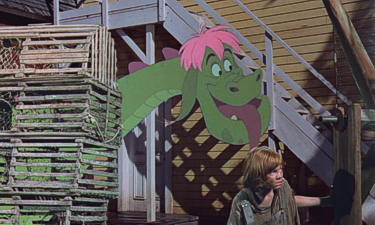
However, while all the other Disney productions were being completed with the Xerox process showcasing the animators’ pencil lines in full force, Elliott is a pure golden age Disney character in pretty much every element (you could say he was an animated cousin to Walt’s own Reluctant Dragon). He’s a “silent” creature, emoting only a few clicks, pops and an occasional growl in communication, so he’s often performing in pure pantomime, about as unadulterated as one can get in animation, and he’s a fully realised personality – we don’t know much about him, but we know everything we need to. Elliott is also brought to life through luxuriously delicate Disney animation that hadn’t been seen since Sleeping Beauty, with fully colored ink lines, beautifully fluid animation and special visual effects integration.
Unfairly, the VFX were not nominated for an Oscar, but the film’s musical score (supervised by the Sherman Brothers’ long-time Studio collaborator Irwin Kostal) and signature song, Candle On The Water, were. The score lost out to Stephen Sondheim’s A Little Night Music (in the days when Score and Song Score were two different things; a little movie called Star Wars walked away with the Original Score statuette), while Candle On The Water (nominated against another Disney tune, Someone’s Waiting For You from The Rescuers) was beaten by You Light Up My Life from the film of the same name – no, I don’t remember it either!

After the film’s premiere, Pete’s Dragon underwent some trimming – something not uncustomary for the post-Poppins pictures when the Studio was antsy that audiences didn’t want too many songs in their musicals. Most audiences, especially those internationally, didn’t even get to see big musical signing Helen Reddy, a hugely popular vocalist at the time, sing Candle In The Water in original release: the original song sequence, an excellent moment where she sings out from the top of her character’s lighthouse in a wistful prayer to both the boy Pete she has taken in and a long-lost love, was cut from the movie and placed over the film’s opening credits (where it may have not even have been heard here but for its Oscar nomination).
This was one of the film’s many production hiccups since originating at the Studio during the 1950s, when Pete’s Dragon was one of the many stories considered for Walt’s anthology show. At that time a dramatic piece, Elliott really was just an imaginary friend and was never to have actually been seen, but when the project was reconsidered (as with many of the 1970s pictures, it was an idea brought back after Walt’s passing) it was proposed that Pete would hide from his troubles by entering his own fantasy world. These bizarre choices sound as if they would clash with the established Disney formula, however, unique they may sound, and the idea for Pete and Elliott to enter a surreal nightmare by accident seems like a lot of money wasted on a movie that just wouldn’t have found an audience.
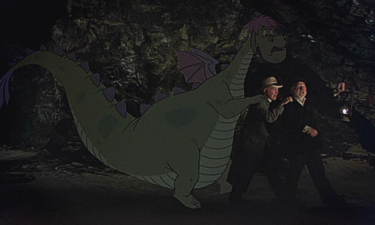
Once the idea to incorporate animation was given the greenlight, the balance began to shift from dramatic to fantasy elements and Ken Anderson’s design for Elliott signalled the kind of picture Pete’s Dragon should be. The Studio’s established songwriters the Shermans, who had both moved on to other projects after not finding the kind of support they had hoped for after Walt died, were replaced by Al Kasha and Joel Hirschhorn, who had won an Oscar for their Poseidon Adventure and were still hot (sorry) after doing the same for The Towering Inferno. A full musical score of songs were written, but many fell by the wayside when Pete’s Dragon was trimmed for international release and home video.
So…this is how I saw the film for many years – the original near 130-minute cut being reduced by around a full half-hour! – and in many ways it’s the tighter, shorter version that I still favor, not only because I knew it by heart but because it is actually, in retrospect, a better movie. Nonetheless the shorter version, in losing some of the extended dance sequences and the Candle On The Water moment, does also unfortunately cut some of the other, just as entertaining numbers. Just as the Studio decided to do with the reconstructed Bedknobs And Broomsticks for its 25th anniversary, so they have decided that this original length Pete’s Dragon be the preferred viewing format for all recent and future editions.

It’s not a decision I’m at odds with, actually: while the shorter version moves along quicker and has a bit less dancing, it also loses some great moments: instead of relegating the signature Candle On The Water to main title tune, the opening features a good old fashioned overture of the score’s songs, while Reddy gets her big emotional moment where it should come in the movie, terrifically and bravely captured in one shot by director Don Chaffey, a Disney veteran also known for The Three Lives Of Thomasina, among others, various television episodes including The Prisoner and experience with combining live-action with visual effects elements (Jason And The Argonauts, One Million Years BC). It really is a pivotal moment in the film, and a rare one when a song and its performer really get the chance to shine, somewhat Broadway style.
Indeed, if they could ever work out how to pull the effects off, I still think Pete’s Dragon would be a marvellous stage production. All of the songs have a timeless, Broadway sound to them (which Kasha and Hirschhorn would later write for), especially the villainous Dr Terminus’ Every Little Piece, in which he and his cohort Hogey dream up all the different ways they can slice and dice Elliott up to use as magical healing potions. As Terminus, British actor Jim Dale eschews the pure comedy of his earlier Cary On… and Digby: The Biggest Dog In The World English appearances for more of the tone he would bring to the Broadway stage (still now a New York resident, his most recent role was in replacing Stephen Fry’s British Harry Potter audiobook readings for the American market).
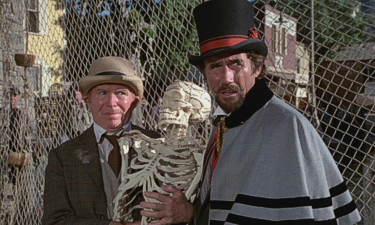
He makes for a perfect Terminus, a typical but definitive oily villain, down on his luck and up to no good, ready to do whatever it takes to stay out of hot water. It’s his pure desire to kill Elliott for his own greed that makes him a truly great Disney villain, and he’s matched in the turn of the century’s period vaudeville tone by Red Buttons as his not so sure-footed sidekick. The rest of the casting is great too: Reddy didn’t go on to a great movie career but she’s perfectly adept here, as is another old trooper Mickey Rooney, unbelievably making his first Disney appearance after decades of playing in MGM musicals and popping up in the likes of the brilliant It’s A Mad, Mad, Mad, Mad World.
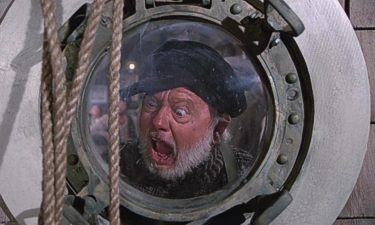
Rooney would stick around the Studio to voice the adult Tod in the 1981 feature The Fox And The Hound (before returning to family fare in the much more recent Night At The Museum and a spot-and-miss cameo in last year’s The Muppets), which another of his co-stars would also do. Newcomer Sean Marshall, auditioned from hundreds if not thousands of kids, doesn’t even get a notice in the film’s contractual credits, but he sure makes an impression here and would do again a year later, in the Bluth-directed classic The Small One. Largely playing against thin air before Elliott was inserted in during post-production, Marshall is simply excellent at making us believe the Dragon is there even when he’s actually invisible.
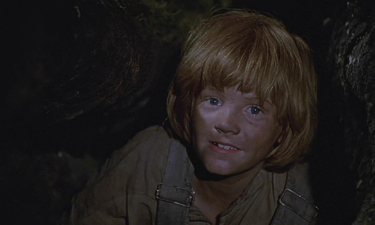
He also gets to sing a couple of the film’s musical numbers and, whatever else one may level at Pete’s Dragon, the lack of memorable tunes can never be one of them: I Love You Too, Brazzle Dazzle Day and It’s Not Easy easily belong in the pantheon of great Disney songs (and get regular impromptu singings around these here parts!). The inclusion of Candle On The Water in its original context really is worth sitting through the material that’s been put back in, too – not that this added content is unwanted! On the whole the extra scenes do much to extend the entertainment; it’s just that I’m so used to the alternate that when a musical beat is missed or there is extra dancing added to I Saw A Dragon!, I miss how the movie used to run, for me at least.
However, the flipside is that we get to see some intended “missing” parts: early on when the twisted Gogan family come to town looking for the hidden Pete, it was always clear from the music and performances, even to us as kids, that the group was about to break out into song…a song that never came. On finally being able to see this material on a previous DVD edition of the movie, everything was clear: there was an intended song here – one that cleverly outlined Pete’s past, his future, and the nature of the Gogans all in one – and it was a good one at that (The Happiest Home In These Hills), giving star-name Shelley Winters a bigger chance to ham it up as the maniacal matriarch eager to put poor Pete back to work on the family farm.

Winters is great value and I would argue that, much later into her renowned career, she had found the perfect role for her unique talents. I’m not being discourteous: there’s no-one else that could have filled these mud-splattered boots as brilliantly as Winters does here, and any overacting or under-singing claims can simply be brushed aside in the clear assumption that she is simply having the fun time of her life after years of heavy dramatic roles (some may also pick out Grease’s Kenickie, the late Jeff Conaway, as one of the Gogan boys, Mr. Magoo himself, Jim Backus, as the town’s Mayor, and even Dale again as one of the tavern drinkers). The rest of the movie is just as good, especially the set design, largely filmed at the Disney Studio and Ranch, supplemented by a real-life, fully-functioning light house built off the Californian coast and perfectly doubling for Pete’s Dragon Maine setting.
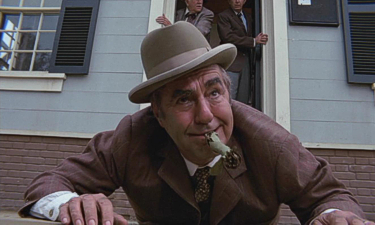
What else can I say about Pete’s Dragon? It’s about as perfect family entertainment can get and I’d bet that most kids of my generation would still say they remember it much more fondly that its post-release reputation would have you believe. I’m not even sure where the box-office bomb accusations come from either: on a $10m budget the film made back almost $40m in initial release, not including its foreign take, reissue, home video and merchandise sales. One can hardly call the film a disappointment: whichever version you may have seen the magic still works today, the songs still lodge themselves in the brain, and it’s overall a lovely little film that, for me, is the perfect creative example of Disney in the mid-1970s. Watching it again now, you’re sure to have a brazzle dazzle time!
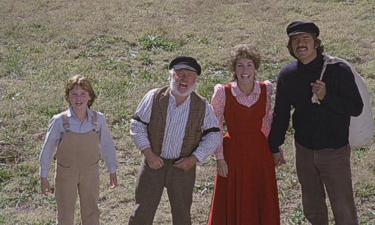
Is This Thing Loaded?
As is sadly the case with the concurrent release of The Great Mouse Detective, Disney seems to be racing through their Blu-ray updates of previously released DVD editions so fast that they’ve given up adding anything new of note to them! Earlier this year, a collection of titles all provided very nice surprises by including one new HD featurette a piece: small but perfectly formed and more than very welcome additions that really put a smile on collectors and enticed them to pick up titles they likely already had once again for more than just increased picture quality.
For The Great Mouse Detective and Pete’s Dragon that thinking has been thrown right out of the window, each title simply coming to Blu-ray in exactly the same editions as their last DVD incarnations in terms of supplemental bonuses – but sadly even losing some extras from those discs! In the case of Mouse Detective that’s unfortunate, since the previous DVD actually contained less material than its initial release, but for Pete’s Dragon it’s absolutely regrettable, since the film got a pretty nifty final DVD issue…well, much better than expected anyway…as what I think was labelled a Brazzle Dazzle or High Flying Edition.
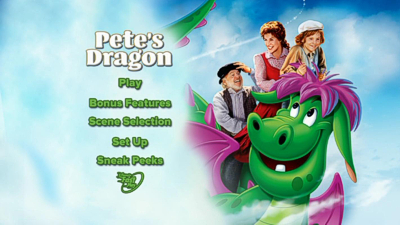
Here any fancy titling is dropped for a basic 35th Anniversary Edition moniker, which seems a license not to bring anything new and exciting to the table but more an opportunity to churn out nothing more than an HD upgrade and actually drop some of the previous extras (see below). Thankfully, the excellent Brazzle Dazzle Effects: Behind Disney’s Movie Magic featurette is still amongst the supplements, a wonderful 25 minute look back at decades of visual effects innovation at the Studio hosted by none other than Pete himself, Sean Marshall! I’m not sure how they enticed him back after essentially abandoning a movie career after just a couple of roles, but it’s a very welcome and cute touch and he makes for a very personable voice-over.
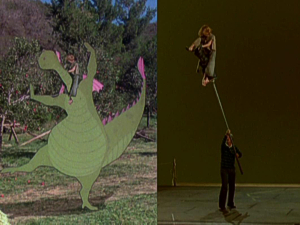
Covering the early days of Walt’s initial Alice Comedies development in combining a live-action girl in an animated world, including hearing from original Alice Virginia Davis in recent archive footage, through the technical advances of Ub Iwerks’ sodium vapor (or “yellowscreen”) process for the 1940s Package Features, Song Of The South, Mary Poppins and others, to the use of the same methods for Pete’s Dragon. There is tons of rarely seen on-set footage (surely much more could have been assembled for this edition?), and Marshall’s recollections sometimes verge on being a mini-commentary, if only for a few minutes, and he reveals why he didn’t continue pursuing life as an actor too.
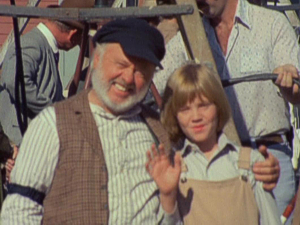
In lieu of an actual commentary, this is as good as it gets, and I would go so far as to say that Brazzle Dazzle Effects is possibly the best of any of the more recently produced supplements for a non-Platinum or Diamond Edition title, well worth the price of the disc alone. In addition, it does a lot to blast any criticism of the special effects techniques of the time: once anyone has seen the sheer level of intricate work involved in matching up just two screen elements in an age before digital imagery made it all too simple – I myself am just blown away by the shadow work added to Elliott’s integration – I’m sure they will give those effects a little more slack. A brilliant inclusion, and essential to have been carried over here.

Some more behind the scenes material is to be found in a Deleted Storyboard Sequence: Terminus & Hoagy Hunt Elliott (2:25), which would have been pretty fun in the finished movie. The same kind of comedy element happens when Lampie takes Hoagy down to Elliott’s cave to show him the dragon, but here it’s (an interestingly much more British-accented close to One Hundred And One Dalmatians’ Horace and Jasper) Terminus who is largely oblivious to Elliott’s playful pranks. A further Original Song Concept: Boo Bop Bopbop Bop (I Love You, Too) (2:35) presents the initial song demo (in terrifically clear audio quality) of Elliott and Pete’s song in storyboards.
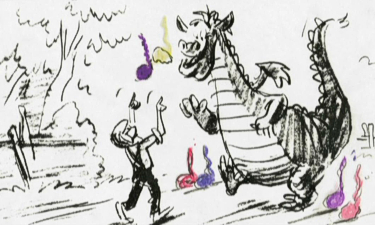
This is again not too different to what ended up in the movie (it seems some ideas in both storyboard offerings here may have been too technically ambitious, hence their not being used), but here Elliott is represented by a Disneyland Electrical Parade-sounding synthesized vocal which is surreally odd, but I like the idea of Elliott’s multi-colored smoke effects! Finally, two Trailers present theatrical reissue and video advertisements for the movie. The exact same extras are shared between the BD and included DVD; both include Sneak Peeks for Cinderella, Wreck-It Ralph, Sophia The First, Peter Pan, Secret Of The Wings, Brave, Cinderella II & III, Finding Nemo and Planes, taking up space better saved for more Pete’s Dragon supplements…

WHAT’S MISSING?
Despite an argument to the contrary in my summary above, Pete’s Dragon has never been seen as one of the Disney Studio’s A-pictures and so a lack of bonus features on any previous edition has been lamentable if not understandable. However, there’s nothing special added here to mark out the film’s 35th birthday in any way, when most of the cast and crew are still around and seem like they would still be happy to reminisce about the film. Certainly Jim Dale was more than pleased to sign my Gold Collection Pete’s Dragon DVD when a mutual friend visited him in New York a few years ago, and it would have been simply magic to have invited him, Marshall, Reddy, Rooney and animation director Bluth together for a unique commentary reunion (they’re all still around, folks!) or even a roundtable retrospective.
Okay, so that’s wishful thinking and, while it would have been great fun to have heard them now, it’s somewhat predictable that Disney wouldn’t necessarily want to shell out on those kinds of elements. So how about at least including some things already on the Studio shelves!? Originally running 134 minutes in its premiere road show edition, this seems to account for a further six minutes of material not inserted back into the movie. I’m not suggesting this be reconstructed for a new cut, but how about letting us see what was deleted (as I understand it, there was more of the film’s opening, including more of the I Saw A Dragon footage)?
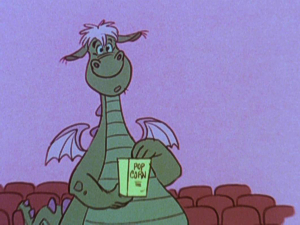
The lazy approach to this edition also runs to not including several extras from the two previous Pete’s Dragon DVDs: from the Gold Collection, the 1970s animated featurette Man, Monsters And Mysteries is missing, as is a Donald Duck cartoon, Lighthouse Keeping (catch the obvious link!), which should both really be here in HD. The special edition DVD issue also contained some more terrific audio treasures: three further original demo recordings (including one for an alternate villain character) and, best of all, pop versions of four songs used to promote the movie – the added “baby I love you” backing vocals made these super-cheesy but super-fun!
They’re a great loss here, and even if the disappearance of a set-top game isn’t as missed at all, the lack of the Pete’s Dragon Art Galleries, five pages of fascinating liner notes, Ken Anderson speaking about Elliott via an excerpt from the Disney Family Album series and additional original trailers are too lamentable in their absence to overlook. Disney could have somewhat made up for this by replacing them with something ultra-cool, but they drop the ball here, too: produced in the same year as Pete’s Dragon, directed by Elliott’s animation supervisor and featuring Marshall on voice duties, Don Bluth’s The Small One is an exceptionally enchanting two-reeler that’s been all-too-rarely available on home video, and never in its original aspect ratio.
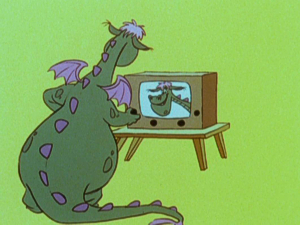
The press release for this edition of Pete’s Dragon even lists Small One amongst Marshall’s limited screen credits and the film’s themes of finding a place for an unusual friend are strongly mirrored in Dragon’s itself. A complete no-brainer if ever there was one, it’s a crying shame that The Small One featurette has not been added as a new extra to this title, for the first time in HD and as a super-exciting enticement for collectors, robbing the disc of an all-too obvious and perfectly suited supplement that might have provided reason itself for fans to pick up Pete’s Dragon again. As such, and despite the welcome Effects featurette, this new BD edition really can’t be recommended for its supplemental package at all.
Case Study:
Can you say lazy, again? Pete’s Dragon comes to disc in essentially the same packaging as before, now “enhanced” with Disney’s blue-colored BD artwork approach. The rest of the artwork matches the previous SE DVD, dropping the Brazzle Dazzle banner (and most of the extras!) for a correct, if bland, 35th Anniversary Edition designation. A nice and shiny, embossed slipcover brings some magic to the treatment, but the back text is as basic as they come, cut-and-pasting the same blurb as found on the concurrent Great Mouse Detective release (“for the first time ever on Blu-ray…”).
NOTE: the sleeve and all the packaging, including the discs, indicate Pete’s Dragon runs 88 minutes. In any of its versions, Pete’s Dragon has never run as short as 88 minutes, so I’ve no idea where that timing comes from: rest assured the movie on both the DVD and the Blu-ray Disc in this set runs for the current full version of 129 minutes.
Ink And Paint:
If there’s one thing the packaging does get right, it’s the announcement of a newly enhanced digital transfer! I’ve never seen Pete’s Dragon looking as spotless as this, and I believe for the first time that we’re also seeing the correct and unmatted 1.66:1 negative ratio as well. Despite its theatrical reputation, the movie has always done well on home video – indeed back in the days of the video sequels, Disney had announced a further adventure for Elliott – and so the Studio obviously felt money was well spent on cleaning up the original film for this HD debut, and I really can’t make enough positive remarks about the new pristine picture quality!

The Disney backlot set of Passamaquoddy comes alive like never before, I noticed several details that I didn’t catch on any number of double-digit viewings in the past, and there’s a real depth to the image that VHS, LaserDisc and even DVD could only ever hope to achieve (indeed, the soft, somewhat bland DVD included here can’t hold a candle to the BD’s fresh and solid reproductions). Sure, some of the visual effects matting may be more noticeable, but only in limited shots: as with the recent new edition for Tron, for the most part you may actually find yourself asking how some things were done, or at least marvelling at the intricate work on show. Exemplary and a joy to watch all over again!
Scratch Tracks:
As much as the picture shines, the same can’t really be said about the sound. Offered in uncompressed DTS-HD Master Audio, the 5.1 track has been pulled from the film’s original Dolby Stereo mix: Pete’s Dragon was the first Disney movie to be recorded in that then-new technology (complete with the “Making Movies Sound Better” logo of the time). Much as how the original Star Wars sounds a little “blanketed” against more modern recordings, this is mostly down to Dolby’s noise reduction process and therefore inherent in the original recordings. Without much to undo, the engineers have done the best they can with the mix: it’s not demo material but the music is clean and the dialogue clear, and again the Blu-ray easily beats out the DVD. A very good and less-noise reduced French Dolby 5.1 track is optional, as are English, French and (although not mentioned on the packaging) Spanish subtitles.
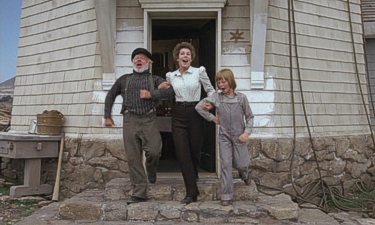
Final Cut:
The lazy packaging incorrections aside, Pete’s Dragon is still a real tough one to recommend or not based on its extras package. Not only does it not bring anything new to the title but it drops a not insubstantial amount of bonuses from two previous DVD editions. The featurette on the Studio and Pete’s Dragon’s visual effects is pretty special itself, but technically it’s a holdover from before, and so much else has been lost that could easily have made for a pretty darned cool catalog edition. However, the movie itself is a wonderful example of what can only be called classic Walt-era entertainment, but from a slightly later time at the Studio.
Certainly Pete’s Dragon deserves its place alongside Song Of The South, Poppins and Bedknobs as a slice of premium animated/live-action family filmmaking, and the scale of the production’s sets are especially striking in HD. It’s just such a shame that the extras fail to support the movie particularly well or even simply carry over what was available before. Fans will want to keep their Gold Collection and previous High Flying Edition DVDs for those extras: this new Blu-ray is as good as a barebones release – unbelievable these days – and is simply all about making the film look good. It does, and remarkably so, but ultimately I can only recommend the movie’s strengths, not this disc treatment.
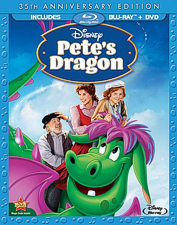 | ||
 |


